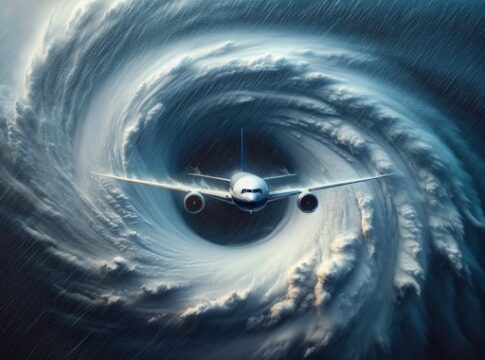Flying directly into the eye of a hurricane with 185 mph winds isn’t insanity—it’s the most critical meteorological mission on Earth, and the brave souls who do it are literally saving thousands of lives with every death-defying flight.
When Science Meets Raw Courage
Picture this: You’re strapped into a military aircraft, engines roaring, as your pilot deliberately steers toward a wall of wind and rain moving at nearly 200 miles per hour. The turbulence is so violent that seasoned veterans grip their seats, yet the crew calmly deploys scientific instruments into the chaos. This isn’t a Hollywood thriller—it’s Tuesday at the office for the Hurricane Hunters, the most fearless meteorologists on the planet.
The Hurricane Hunters operate from two primary organizations: NOAA’s Aircraft Operations Center and the U.S. Air Force Reserve’s 53rd Weather Reconnaissance Squadron. These teams pilot heavily instrumented WP-3D Orions and WC-130J aircraft directly into the most dangerous storms on Earth. Their mission is deceptively simple yet extraordinarily complex: fly through hurricane eyewalls multiple times during 8-10 hour flights, dropping GPS-equipped instruments called dropsondes that transmit critical atmospheric data back to meteorologists.
Born From a Bet, Forged by Necessity
The Hurricane Hunters didn’t emerge from some bureaucratic committee—they were born from pure American audacity. In 1943, two Army Air Corps pilots made a bet about whether anyone was crazy enough to fly into a hurricane. One pilot took the dare, successfully penetrated the storm, and accidentally launched one of the most important meteorological programs in history. What started as military bravado became an essential public safety operation after devastating hurricanes like Carla in 1961 demonstrated the urgent need for better storm forecasting.
😳 Video from inside the plane of the U.S. Air Force Reserve's 53rd Weather Reconnaissance Squadron, which flew inside the eye of Category 5 Hurricane Melissa.
No Freaking Way 🤢 pic.twitter.com/uMrxUgG1T7
— JC Vollentine (@Theonlyjcvolly) October 29, 2025
The early missions used basic World War II-era aircraft with rudimentary instruments, making them exponentially more dangerous than today’s flights. Crews relied on mechanical barometers and visual observations while battling winds that could literally tear aircraft apart. Several planes and crews were lost in those pioneering decades, leading to the rigorous safety protocols and advanced technology that make modern Hurricane Hunter missions survivable, though never safe.
Technology That Turns Terror Into Data
Modern Hurricane Hunter aircraft are flying laboratories equipped with dual Doppler radar systems, GPS dropsondes, and atmospheric sensors that would make NASA jealous. The WP-3D Orion aircraft, nicknamed “Kermit” and “Miss Piggy” by NOAA crews, can withstand tremendous punishment while maintaining the precise flight patterns needed for accurate data collection. These aren’t your typical weather forecasting tools—they’re military-grade instruments designed to function in conditions that would destroy conventional equipment.
The dropsondes represent perhaps the most ingenious aspect of hurricane reconnaissance. These GPS-guided instruments, deployed directly into the storm’s eye and eyewall, transmit real-time measurements of wind speed, pressure, temperature, and humidity as they fall toward the ocean. This data reaches the National Hurricane Center within minutes, providing forecasters with the precise information needed to predict a storm’s intensity, track, and potential for rapid strengthening or weakening.
The Million-Dollar Question: Why Risk Human Lives?
Critics occasionally question whether unmanned drones could replace human crews, eliminating the risk to life. The answer reveals the irreplaceable value of human judgment in extreme conditions. Satellite data, while useful, cannot penetrate deep into a hurricane’s core structure. Unmanned systems lack the real-time decision-making capability needed when encountering unexpected storm behavior or equipment failures at 10,000 feet inside a Category 5 hurricane.
Watch as hurricane hunters enter straight into the eye of Hurricane Melissa and experience extreme turbulence. The flight crew was collecting data from the eye of the hurricane as it swept across the Caribbean Sea. After passing through Jamaica and Cuba, the storm is set to hit… pic.twitter.com/HB4CzRGqzS
— ABC7 News (@abc7newsbayarea) October 30, 2025
The economic argument for Hurricane Hunter missions is overwhelming. Improved forecast accuracy translates directly into more efficient evacuations, better disaster preparedness, and billions of dollars in avoided damages. When Hurricane Hunters provide data that allows meteorologists to narrow a storm’s predicted landfall by just 50 miles, entire cities can make more informed decisions about resource allocation and evacuation timing. The cost of operating these missions pales compared to the potential savings in lives and property.
Sources:
NOAA Virtual Lab – Then and Now: NOAA Hurricane Hunters
Vintage Aviation News – The History of the Hurricane Hunters
U.S. Air Force Reserve – 53rd Weather Reconnaissance Squadron


